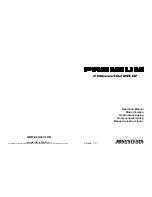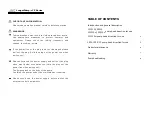
DE3191
1
0&5
Wireless Interface for Hard-Wire Control Panels
Installation Instructions
,1752'8&7,21
3XUSRVHDQG8VH
The MCR-308 is a wireless PowerCode receiver designed to
convert a regular hard-wired control panel into a hybrid wireless
system, as demonstrated in Figure 1.
With the MCR-308 serving as an interface between wireless
transmitters and the control panel, the control panel’s zone inputs
“see” regular wired loops, as if they were directly connected to
hard-wired devices. The states of the receiver outputs determine
whether the control panel’s zone inputs are in alarm or not.
A notable feature of the MCR-308 is its compatibility with both
regular PowerCode and Code-Secure™ transmitters. Code
secure™ transmitters are mainly used to arm/disarm an alarm
system or in other control applications, to prevent “code grabbing”
by people with malicious intents.
Three operating modes are available:
Normal - the receiver stands by for regular reception
Learn - registration of transmitter and expander IDs in the
MCR-308 memory
Test - allows the installer to test the system.
=RQH2XWSXWV
The MCR-308 features 4 zone outputs (expandable to 28 outputs
- see Para. 1.6). Each zone output can learn the ID codes of up to
4 transmitters/detectors deployed within the protected site (see
Para. 1.4 below).
Figure 1. Typical Application of the MCR-308
6WDWXV2XWSXWV
In addition to the 4 zone outputs, the MCR-308 provides 4 status
outputs that function as follows:
Tamper: This output is activated once a TAMPER state is
detected in a transmitter, in an expander unit or in the
MCR-308 receiver itself.
Inactivity: This output is activated if a supervised transmitter
fails to send its attendance message within a 4-hour time frame,
and also upon sensing expander inactivity for 10 seconds.
Low Battery: This output is activated once a low battery
message is received from one of the transmitters/detectors.
The output is reset by replacing the battery in the transmitter
that sent the low battery message and transmitting once again.
Jamming: This output is activated if an interference (channel
jamming) is detected on the RF channel for more than 30
seconds. It is reset a few seconds after the jamming stops.
/HDUQLQJ&DSDELOLW\
For proper operation, the MCR-308 must be “taught’ the ID code
of each wireless transmitter used in the system and of each
MCX-8 expander added to the system. Thus, each transmitter is
associated with the actual zone output it is meant to trigger
(4 transmitters are allowed per zone output), and each expander
(if used) will be recognized by the MCR-308. Detailed teaching/
learning procedures are provided in Paragraphs 3.5 and 3.6.
&RQVWUXFWLRQ'HWDLOV
The MCR-308 consists of a motherboard that accommodates the
processing circuitry and the RF receiver module. The entire
assembly is packaged in a plastic two-part cabinet, with vacant
space for an expander module that adds 8 outputs to the receiver
(see details in Paragraph 1.6).
A semi-rigid vertical antenna is connected to a special screw
terminal located at the top edge of the motherboard.
Figure 2. MCR-308 with Cover Removed
6\VWHP([SDQVLRQ2SWLRQ
Although the MCR-308 provides only 4 zone outputs, its span of
control can be increased by adding MCX-8 expander modules,
connected via a 4-wire expansion bus (see Figure 3).
Three expanders may be added to a single MCR-308 unit. Each
expander provides 8 additional outputs, and together with the 4
zone outputs of the MCR-308 the total number of zone outputs
will amount to 28.
Twenty eight zone outputs multiplied by four wireless devices per
output produce a total of 112 differently coded wireless devices
that can be used in a single system.
Figure 3. Expanded System Configuration
/(')XQFWLRQVGXULQJ2SHUDWLRQ
The MCR-308 has two LED indicators:
•
The SIGNAL indicator (red)
•
The TROUBLE indicator (yellow)
SIGNAL indicator: This LED lights steadily for 2 seconds upon
reception of a valid message. If noise or unrecognizable RF
signal are received, the LED flickers.
























